When the US court dismissed two antitrust lawsuits against Facebook because the attorneys failed to prove monopolistic status, the complications of calculating market share in a digital context were on full display.
Though the stakes likely aren’t as high for your business, knowing how to identify your market share is still an important part of the market research process. Whether you’re looking to break into new markets, capture a larger share of your current market, or keep other companies from encroaching on your share, knowing how much of your market you own is key.
With giant brands—think P&G, Coca-Cola, or Tesla—large analytics firms publish annual reports that track their market share shifts. But if you aren’t operating on that scale, and especially if you have an online business, there are other ways to calculate market share without involving expensive and often lagging third-party analytics.
This post will walk you through all the essentials of market share assessment and highlight some of the top market share growth tactics.
What Is Market Share?
In the traditional sense, market share is always about sales. So, if you Googled “market share definition”, you’d get something like this:
“Market share is the percent of total sales in an industry generated by a particular company.” — Investopedia
Essentially, if you’re operating in a billion-dollar market, and your annual revenue is at $100,000,000, you have a 10% market share.
In the online space, however, it’s not just about sales. In Facebook's case the main service they provide—social networking—is actually free. The advertising dollars they receive are part of a different market. So, in this case, the way in which market share is defined gets a bit more complicated.
With online businesses, there are multiple ways to measure market share. You could measure active users, traffic, and other criteria instead of just considering sales.
Whatever criteria you use, it's important to remember that market share is never a constant number. It’s prone to change, so if anyone’s talking about market share, they tend to imply specific time periods—quarterly or annual stats.

How is Market Share Calculated?
There are a few popular ways to calculate market share:
The classical market share formula is based on the industry’s total sales The customer market share formula is customer-centric, so you have to know the total number of customers within your market The relative market share formula is based on the market shares of your industry’s key players The market share growth formula relates to all three of the above, allowing you to see how your market share has grown over timeIn the online realm, however, sales and customers can be easily replaced by traffic, as the former numbers can be difficult to grasp unless you’re dealing with a market full of public companies.
Market Share Formula
Find your company’s total sales for a preferred period, and divide that number by the industry’s total revenue during the same period; then multiply the number by 100 to get a percentage amount.
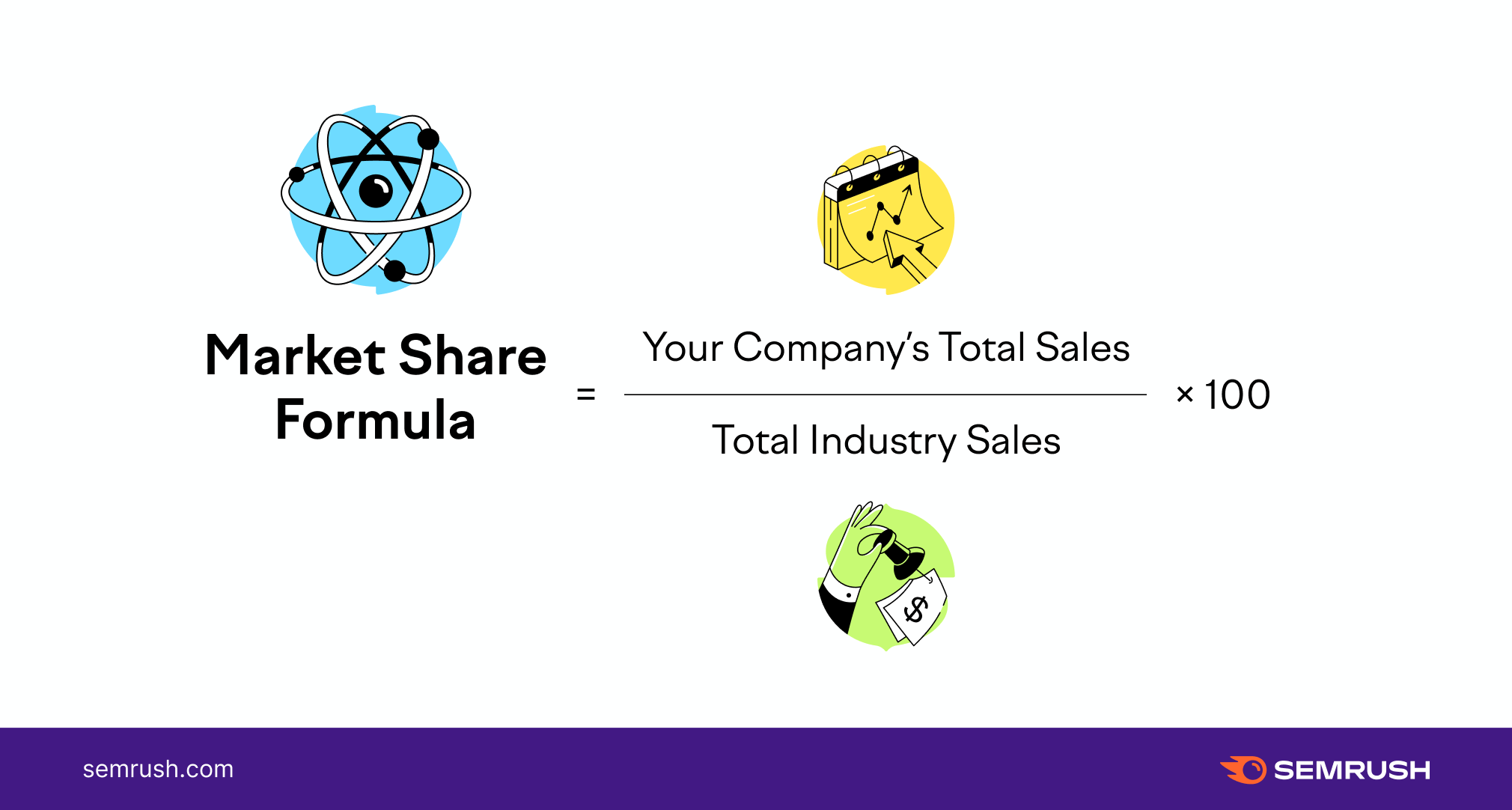
For instance, let’s say you sell shoes and your total sales for a quarter equaled $100,000. During that same time period, total industry sales were $1,000,000. Your market share would equal 10%.
The exact formula would look like this:
$100,000 / $1,000,000 = 0.10 x 100 = 10% market share.
This metric will give you an overall understanding of your company’s position within the industry. However, try to compare yourself against direct competitors. Otherwise, this won’t be a valuable metric for you to track.
Customer Market Share Formula
In some cases, you might measure market share by the number of customers instead. This is usually the preferred method for more prominent industries, which tend to have these figures readily available.
In this case, you trade sales for customers to get a similar percentage amount.
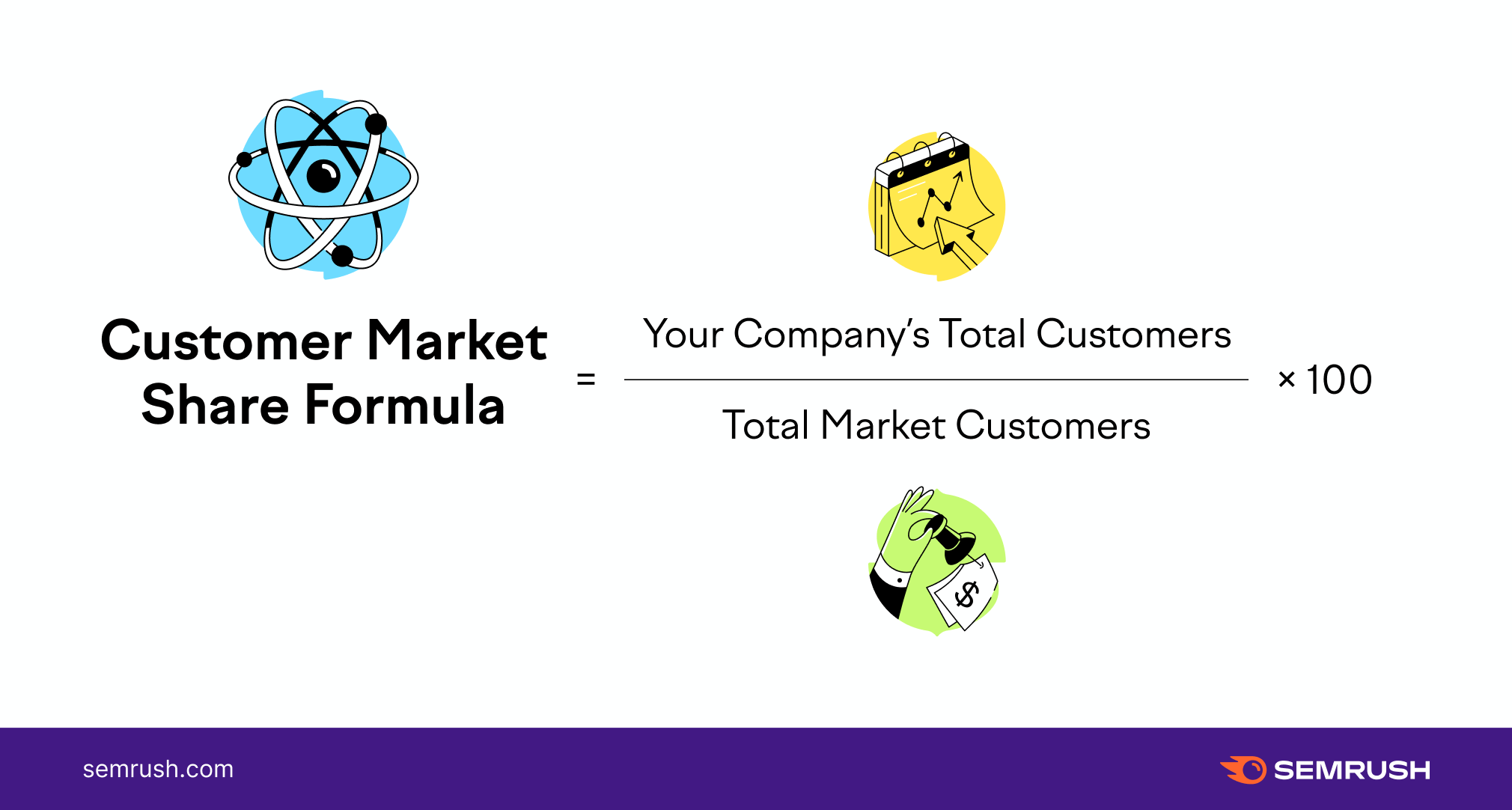
Keeping our shoe company example, say you have 50,000 customers during that same quarter. The business is located in an area where there are 1,000,000 shoe customers during that same period.
So, the formula would look like: 50,000 / 1,000,000 = 0.05 x 100 = 5%
Relative Market Share Formula
Another way is to compare your performance to industry leaders. Here, you divide your market share by your top industry competitor’s market share. Then, multiply this result by 100 to get a percentage amount.
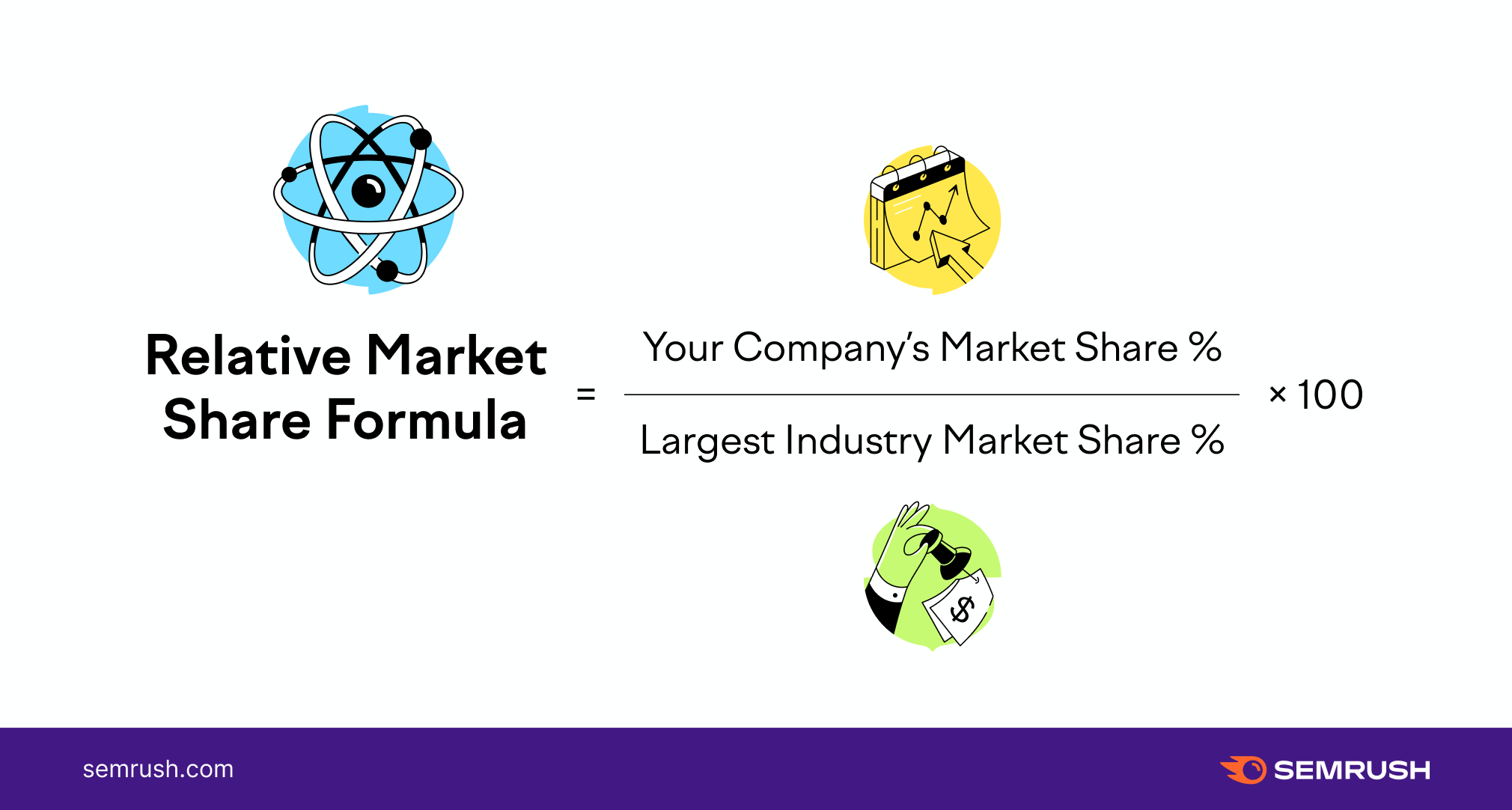
Using the previous example, let’s say the largest direct competitor has a 45% market share.
Then, your relative market share formula would look like this:
10% / 45% = 0.22 x 100 = 22% relative market share.
The result is your portion of the market in relation to your largest competitor. This metric could serve as a more accurate representation of your business’s financial state.
Change in Market Share Formula
To track market share growth, you’ll need to compare your market share numbers across different points in time.
Let’s say in April of 2021 our market share was 10%, and by April of 2022 it had grown to 25%.
In this case, our market share has increased by 15 percentage points.
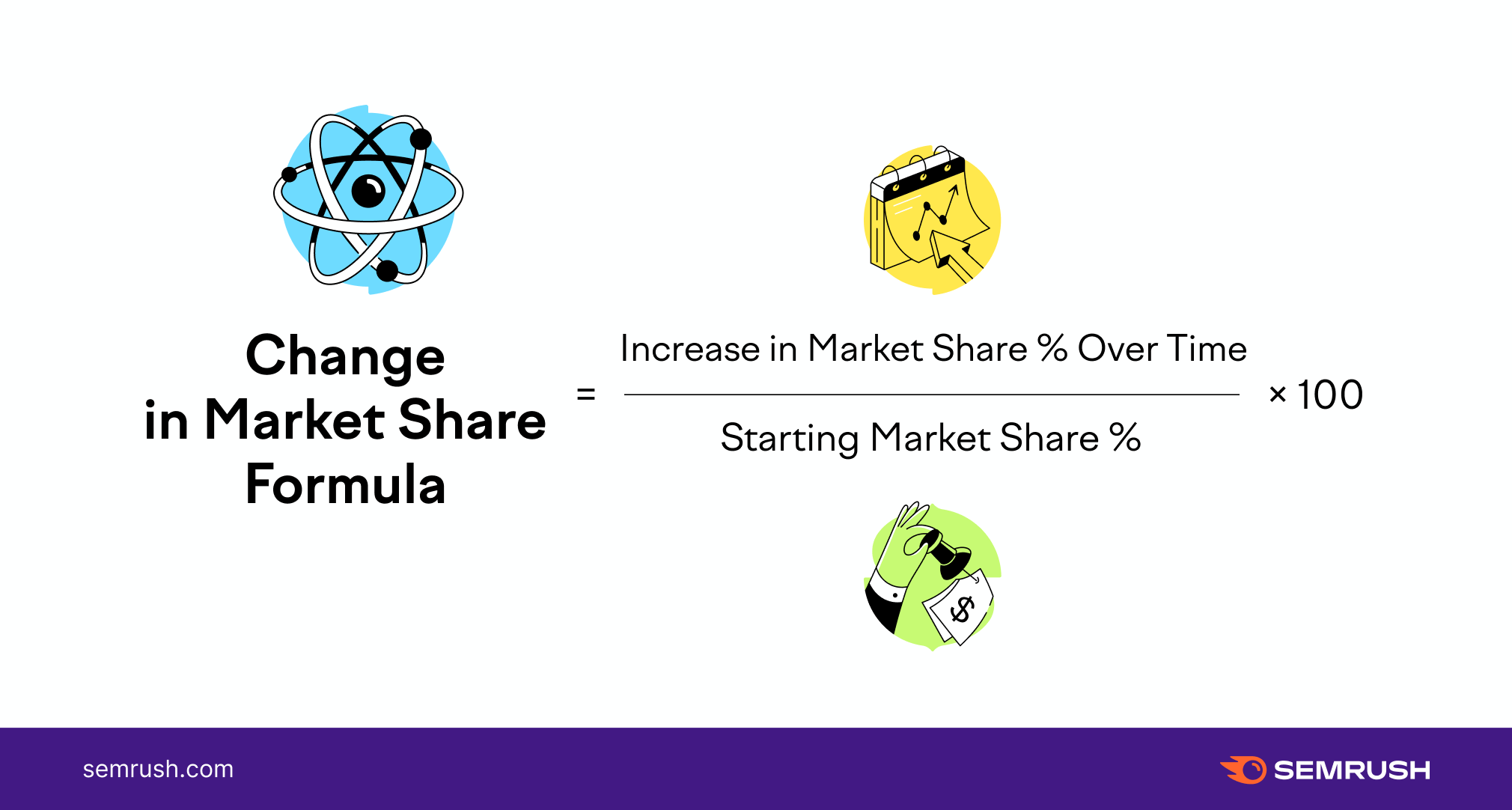
To figure out the growth rate, we’d divide the increase by the original market share and multiply by 100. This means last year our company market share grew by 150%.
Your market share growth calculation would look like this:
15% / 10% = 1.5 X 100 = 150% increase over time.
Conducting an Online Market Share Analysis (With Semrush)
In the online realm, market share can (and should) be calculated based on traffic numbers, and in this case, you can use Semrush Market Explorer’s intel, which can:
Assess the size of your market and your site’s market share, and compare these numbers to various markets (you can specify the geographical location) Select the closest competitors based on organic traffic counts and target audiences Get estimates on competitors’ market share to benchmark and evaluate your online performance.With the goal of exploring the Market Explorer tool, let’s imagine Warby Parker, a NY-based eyewear brand that operates both online and offline, wanted to assess its online market share.
Here are the key market share related insights they might gather:
1. Explore Market Size and Predict Market Share Growth Potential
Entering Warby Parker into the Market Explorer tool automatically generates the Overview Report, which reflects the key aspects of the market for a broad understanding. At the top of the report, you’ll discover the Market Summary, which offers a number of useful metrics.
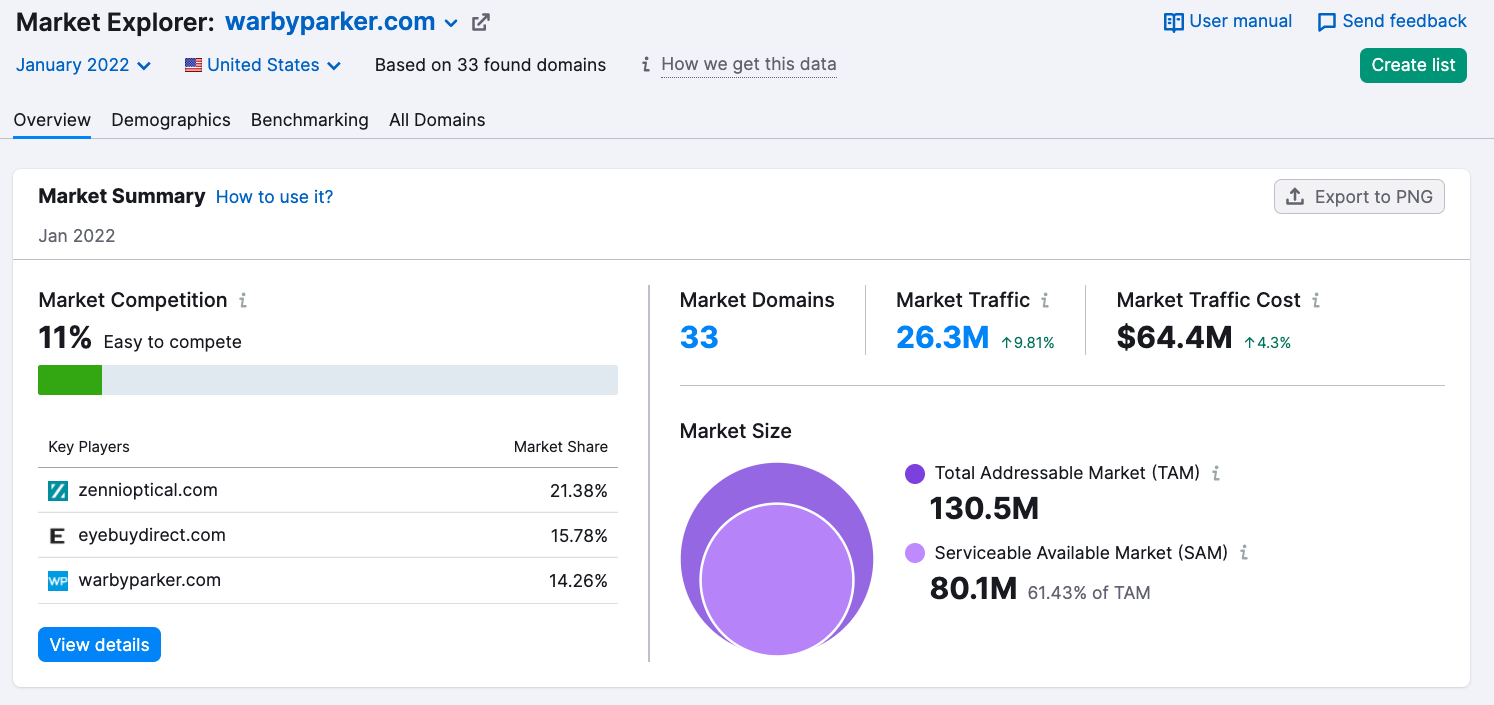
Online, Warby Parker’s market share in the US in January 2022 was at 14.26%—this stat is based on the brand’s January traffic count in relation to the overall market traffic.
Looking at the Market Size section, we can begin to work out market growth potential. To do this, we need to understand the Total Addressable Market (TAM) and the Serviceable Available market (SAM).
The Total Addressable Market is the total amount of demand for any product or service within a given market. It’s important to remember that TAM reflects units of demand, not individual customers, as one customer may purchase several pairs of glasses or a variety of accessories. The Serviceable Available Market is the share of consumers within the total addressable market who need, want, can afford, and are ready to buy a product or service. You can consider SAM the entire target market share formula.Taken together, these two numbers can help begin to estimate the amount of market potential and strategize about ways to increase your market share.
For example, looking at Warby Parker’s market, it looks like their SAM is quite large compared to their TAM. This means they have the potential to reach a large percentage of their total market if they can continue to take market share from their competitors.
2. Establish Key Market Players and Their Market Share Growth Rate
Warby Parker’s 14.26% market share number doesn’t reveal much if we don’t consider market share patterns across the board.
The Growth Quadrant widget provides a full competitive landscape overview by pulling the key market players and returning stats on their growth over a selected time period.
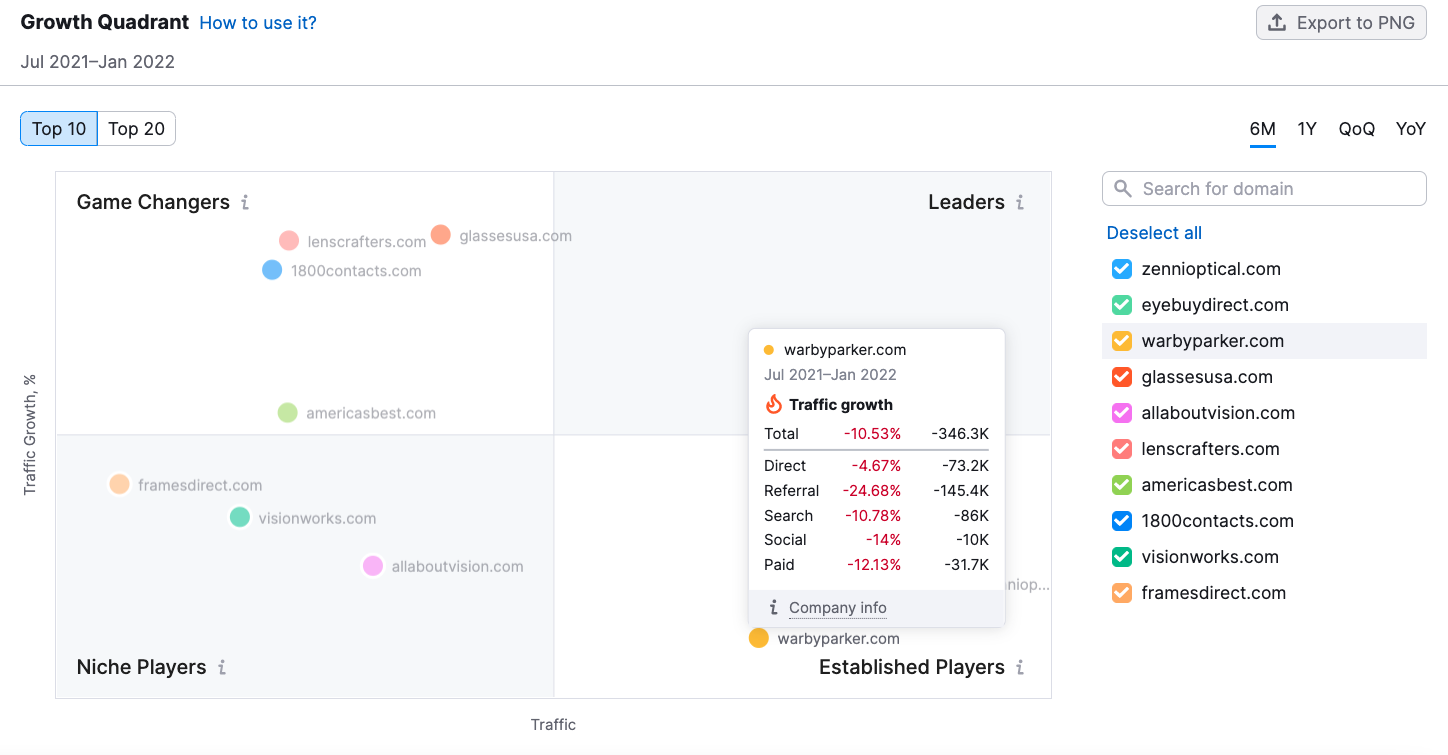
In this case, this market share number appears to put our brand as an established player, a strong position for any business, though becoming a market leader is the goal.
Within the Growth Quadrant, competitors are broken down into various segments that signify their position in the market:
Niche players: Businesses with a smaller market share relative to the rest, and a lower growth rate compared to the market overall Game changers: Companies with small traffic volumes, but growth rates higher than the market average. Startups or large companies entering new markets usually fall into this category Leaders: Businesses with a significant traffic volume and continuous growth rate Established players: Companies with significant traffic volumes, but lower growth rates compared to the overall market. Established brands with name recognition make the most of this category.For each competitor, the widget displays the key stats you have to be aware of—the estimated traffic volume and growth over the time period.
3. Benchmark Your Market Share Against the Competition
If the Growth Quadrant returns absolute numbers (traffic, growth %), you also have to get into comparison mode and stack your market share up against competitors.
This is where the Share of Visits section comes into play.
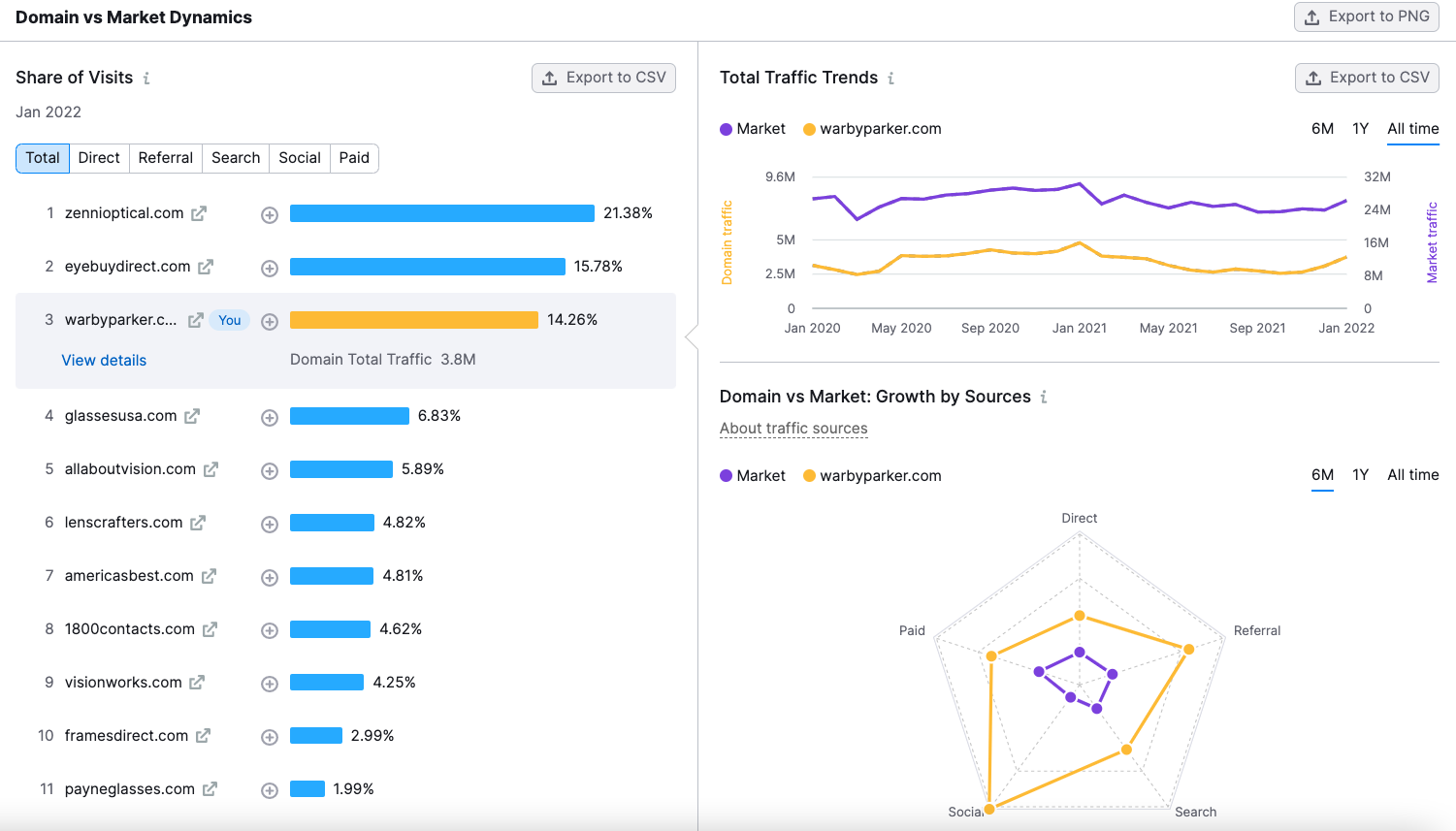
We can see that while Warby Parker is placed in the Leaders category, it has a much bigger competitor—Zennioptical—who has a 21.38% market share. And Eyebuydirect actually comes very close and poses a potential threat to Warby Parker by having an 15.78% market share.
Ways to Increase Your Company’s Market Share (With Examples)
Whether a market leader or a niche player, you need to keep innovating to maintain and/or expand the percentage of an industry you own.
To make this happen, companies have to focus on growing their customer base, be it online or offline customers.
Here are some ways to increase market share:
1. Follow Pricing Trends
Lower prices can be a quick and effective way to bring in more customers. Periodic discount campaigns that can compete with the competition can bring in new footfall.
You can either start with a lower pricing strategy overall—think how H&M’s low costs turned it into the world’s second-biggest apparel brand by market share—or simply offer seasonal discounts and other incentives (this post reveals how Black Friday affects traffic trends across industries).
2. Innovate
Introducing new features and products or expanding ecommerce options is another way to grow your market share. Use existing data, customer feedback, and competitor analysis to make informed decisions about new product development that can boost your market share.
Besides, many of these new consumers will become loyal customers, decreasing your competitors’ market share.
Innovation does not necessarily imply Tesla-like new model launches. You can even think of Starbucks’ successful approach to embracing seasonal trends by offering Halloween/Xmas/etc.-inspired drinks and products.
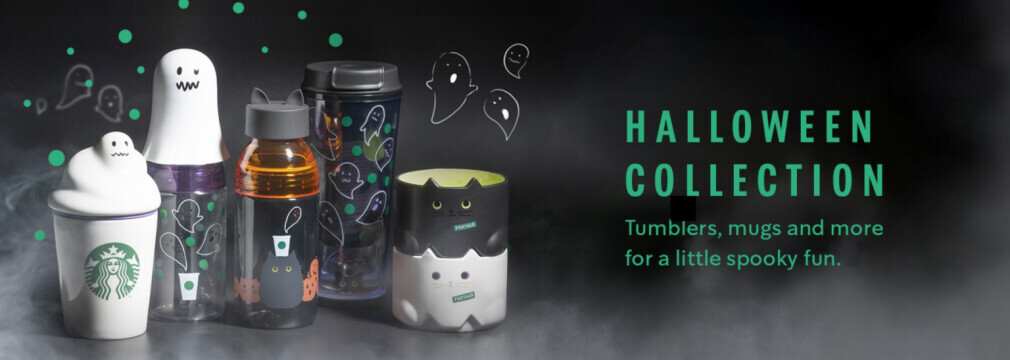 Image source: Soranews24
Image source: Soranews243. Focus on Customer Retention
Strengthen customer relationships and build their loyalty to prevent customers from choosing a competitor if they come up with discounts or new offers.
Gaining market share via referrals and customer satisfaction can increase your company’s revenue without increasing marketing expenses. After all, as an iPhone owner, you’ll be much less likely to choose a shiny new Samsung over another iPhone since you can transfer all your phone data into a new iPhone in a click.
4. Find New Demographics
Appealing to new demographics goes hand in hand with building new products and features. Watch out for market gaps your competitors miss and look for opportunities to serve this audience.
The best example is McDonald’s’ expanding healthy menu options that show how the brand tries to tackle the growing market of customers who prefer to eat healthy.
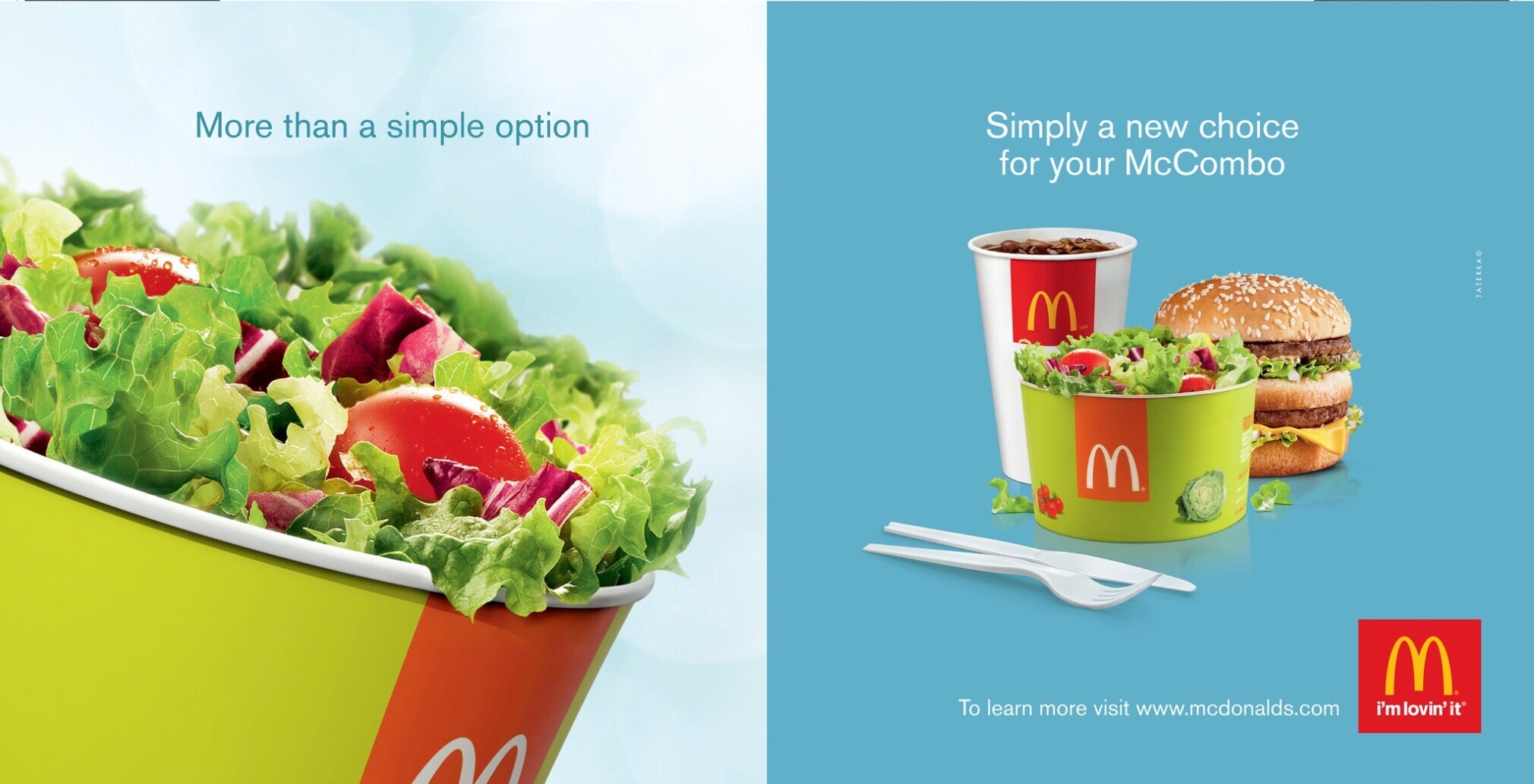 Image source: The New York Times
Image source: The New York Times5. Acquire Other Companies
Another way to increase market share is by acquiring competitors. Of course, this is a play for larger companies with plenty of capital. With acquisitions, you can tap into the acquired firm’s existing customer base and reduce the number of companies fighting for the same market.
Facebook’s acquisition of Instagram and WhatsApp is the most striking example here, as the company now owns the four most downloaded apps of the decade.
6. Increase Brand Awareness
Efficient branding and marketing tactics can play a significant role in expanding your market share. The more customers know who you are, the more chances you have of capturing them. Building brand awareness can help you become a preferred brand in the industry to boost your market share.
The Dollar Shave Club ad that went viral (it has more than 27 million views) and opened up the brand to all imaginable audiences is already a classic example of an excellent brand awareness stunt.

7. Learn from Competitors with Large Market Shares
Using tools like our Market Explorer, you can better understand what the competition is doing to gain their market share.
By looking at the Traffic Generation Strategy and the Social Media Distribution Strategy graphs, you can tell what acquisition channels your competitors leverage to reach a wider audience and evaluate each channel’s efficiency.

Use this tool to learn from the market leaders and their successful tactics for ongoing growth. For more granular traffic insights, you can leverage the power of Traffic Analytics.
Check the Assumptions of Your Market Share Increase Formula
The formulas, metrics, and strategies we’ve explored in this post can go a long way in helping you calculate your market share and grow it. But before you go too deep, check your assumptions and make sure the metrics you’re gathering are the right ones.
Here are a few questions to ask yourself before diving in:
Am I looking at the right metrics? The classic sales-based approach to market share might not be relevant to all businesses. So, for businesses that rely on their online presence, it can be more helpful to look at market share from a traffic perspective. How is brand mix having an impact? Whenever companies add or take away brands, products, and services from a specific category, their market share changes. How are location and region at play? One of the most impactful variables in market share is geography. Drilling down into your regions can provide new perspectives. How am I going to track progress and calculate the growth rate? Market share is not a metric you can track once and then rely on for years to come. Each quarter can come with growth or decline, so you need to keep a close eye on your and your competitors’ market share stats.With these questions in mind, you’ll be able to sort through your data and develop clear insights that will inform your strategy and help your business grow.
Innovative SEO services
SEO is a patience game; no secret there. We`ll work with you to develop a Search strategy focused on producing increased traffic rankings in as early as 3-months.
A proven Allinclusive. SEO services for measuring, executing, and optimizing for Search Engine success. We say what we do and do what we say.
Our company as Semrush Agency Partner has designed a search engine optimization service that is both ethical and result-driven. We use the latest tools, strategies, and trends to help you move up in the search engines for the right keywords to get noticed by the right audience.
Today, you can schedule a Discovery call with us about your company needs.
Source:





